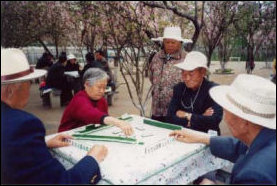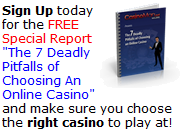History of Mah Jong after 1920
When the West "discovered" the game around 1920 the Mah Jong craze enlarged by another factor again to encompass much of the world. Many regions in the Far East play a game akin to the classical Chinese form but in particular, the British, the Americans and the Japanese all grabbed the game and ran with it in their own direction.
 Mah Jong first hit Japan in 1907 and, like North America and the British
Empire, became a fad in the 1920s. A similar but less dramatic experience
to that of America occurred in that the initial game was simplified and then
complicated again with new rules. However, the Japanese managed to do this
without completely altering the underlying nature of the game and thus the
game has remained steadily popular.
Mah Jong first hit Japan in 1907 and, like North America and the British
Empire, became a fad in the 1920s. A similar but less dramatic experience
to that of America occurred in that the initial game was simplified and then
complicated again with new rules. However, the Japanese managed to do this
without completely altering the underlying nature of the game and thus the
game has remained steadily popular.
Japanese rules take two general forms - those adopted officially by the Japanese Mah Jong Association and "riichi", all the unofficial but sometimes more popular versions played by casual players. However, the main differences from the classical Chinese game are consistent in both. The primary modification is that the winner is paid by all players so that there are no points for second place. Unlike other variants, therefore, each Japanese round is an all-out race to be the first to go Mah Jong as opposed to a more careful campaign with the long term objective of amassing the greatest number of points over a series of games.
Mah Jong was taken to America by Joseph P. Babcock who began importing sets in bulk to the USA in 1922. In order to make it a commercial success, Babcock heavily simplified the rules, much of the interesting intricacies of play being removed. While this worked to a degree because the game did indeed become popular very quickly, Americans were not satisfied for long with this version. Consequently they began to embellish it, by the addition of an array of weird and wonderful "special hands" that allowed one to go Mah Jong and other new rules supposed to increase the enjoyment. The result was confusion. The two most popular variations of the game in 1924 were the One-Double and the Cleared-Hand games and little was known of the classical form from China. While superficially more enjoyable, after a short time, people lost interest in these games and consequently, the Mah Jong bubble burst.
In 1935, the game began to gain again in popularity in America based on newly published rules from the The National Mah Jong League Inc. who still claim to produce the "official" American rules. Unfortunately, rather than go back to the essence of the original form, the same error was repeated and an effort to simply fix the flawed existing American games was made. This complicated and pushed American Mah Jong even further from the original form. Indeed, it is now so different from the original Mah Jong that it is effectively a different game, it's most notable feature being the enormous number of legal special hands.
In Britain, an explosion of interest occurred about the same time as the initial bubble in America and this was mirrored in many other parts of the British Empire, especially in India. Both the American and the Chinese forms were played but, unlike most Americans, the British understood that the Chinese version was the "real" game and that the American and other versions were modern forms. The most popular variations were based on semi-official rules in circulation - The Queens Club Rules and the rules laid down in a booklet by C.M.W Higginson. Both of these were based on Chinese variants which probably accounts for the fact that the game remained popular in Britain well into the 1930s - considerably longer than in America - although interest dwindled between the wars. Nowadays, although the usual proliferation of rules exists, the British Mah Jong Federation publish a set of rules that are a distillation of the way that Mah Jong has been played in Britain during the 20th century and these rules are closer to the Chinese game than the Japanese or American varieties. The main differences are that only one Chow is allowed per person per round and that a few additional special hands are permitted.
Gambling Newsletter

Casino of the Month









